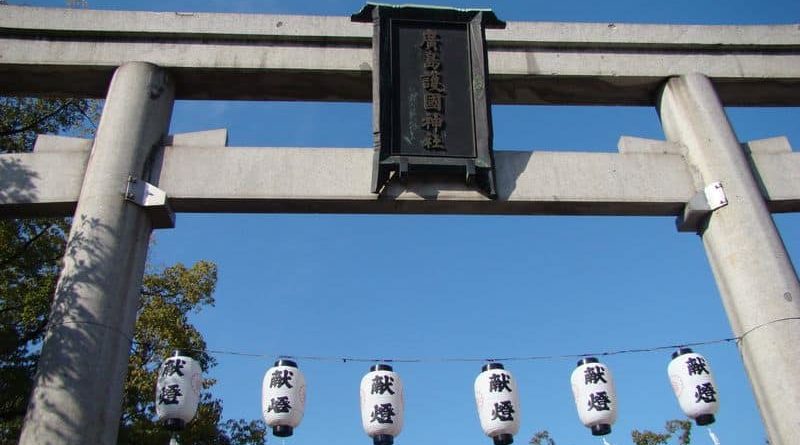Gokoku-jinja Shrine
“Gokoku” shrines are Shinto shrines designated as places of worship for those who have died in war. Like the controversial Yasukuni Shrine in Tokyo, what became Hiroshima’s Gokoku Shrine was also originally constructed in 1868 to commemorate the Hiroshima-han victims of the Boshin War.
78 souls (柱/hashira) were enshrined in the Futaba-no-sato shrine named Mikureisha (水草霊社). Eventually the total number of souls enshrined reached 92,700; the soldiers from the former aki-no-kuni (now western Hiroshima Prefecture) who died in Japan’s wars up until the start of the Great East Asian War (as the 2nd World War post Pearl Harbor is known in Japan) and some 10,000 workers and volunteer corps stationed in Hiroshima who lost their lives to the A-Bomb.
In 1934 it was dismantled, rebuilt in a corner of the west wing of the military parade ground, where the Hiroshima Municipal Baseball Stadium stood until the end of 2008, and renamed Kansaishoukonsha (官祭商塊社) . In 1939 its name was changed by order of the Interior Ministry to the Hiroshima Gokokujinja. In 1945 it was destroyed by the atomic bombing, and rebuilt on the current site within the grounds of Hiroshima Castle in 1956 with the aid of donations from the citizens of Hiroshima. The current main building is even more recent, rebuilt in 1995, when the grand stone slab approach was also added.
There are ceremonies held throughout the year and Gokoku Shrine is one of the most popular places in Hiroshima for celebrating hatsumode at when over half a million people pack the concourse in the first seven days of the year. The local baseball team also make a spring visit to pray for a successful season every year in March.
Ceremonies
- Genshi-sai (元始祭)
Jan 3 10am
New Year’s ritual which according to the Japanese Wikipedia entry dates all the way back to 1870 - Tondo Matsuri (とんど祭)
Jan 15 10am - Setsubun-sai (節分祭)
Feb 3 3:30pm - Kigen-sai (紀元祭)
Feb 11 10am
Ritual commemorating the foundation of Japan. - Kinen-sai (祈年祭)
Feb 17 - Shunbun-sai (春分祭)
Spring solstice 10am - Shunki-taisai (春季大祭)
2nd Sunday of April 10:30am - Showa-sai (昭和祭)
April 29 10am - Natsu Ooharai (夏越大祓)
June 30 4pm - Mantou-mitama-sai (万灯みたま祭)
Last Friday, Saturday and Sunday of May 6:30pm - Genbaku-irei-sai (原爆慰霊祭)
Aug 6 10am8 - Eirei-kansha-sai (英霊感謝祭)
Aug 15 10am - Shuubun-sai (秋分祭)
Autumn solstice 10am - Shuuki-taisai (秋季大祭)
3rd Sunday of October 10am - Meiji-sai (明治祭)
Nov 3 10am - Shichi-go-san-sai (七五三祭)
Nov 15 9am - Niiname-sai (新嘗祭) Harvest festival
Nov 23 10am - Tenchou-sai (天長祭)
Dec 23 10am - Toshikoshi-no-ooharae (年越大祓)
Dec 31 5pm - Joya-sai (除夜祭)
Dec 31 12am - Nikku-sai (日供祭)
Every day 10am - Getsurei-sai (月例祭)
5th of each month 10am
View Gokoku-jinja Shrine [広島護国神社] in a larger map








